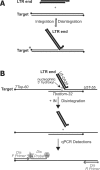Role of metal ions in catalysis by HIV integrase analyzed using a quantitative PCR disintegration assay
- PMID: 17085478
- PMCID: PMC1693899
- DOI: 10.1093/nar/gkl862
Role of metal ions in catalysis by HIV integrase analyzed using a quantitative PCR disintegration assay
Abstract
Paired metal ions have been proposed to be central to the catalytic mechanisms of RNase H nucleases, bacterial transposases, Holliday junction resolvases, retroviral integrases and many other enzymes. Here we present a sensitive assay for DNA transesterification in which catalysis by human immunodeficiency virus-type 1 (HIV-1) integrase (IN) connects two DNA strands (disintegration reaction), allowing detection using quantitative PCR (qPCR). We present evidence suggesting that the three acidic residues of the IN active site function through metal binding using metal rescue. In this method, the catalytic acidic residues were each substituted with cysteines. Mn2+ binds tightly to the sulfur atoms of the cysteine residues, but Mg2+ does not. We found that Mn2+, but not Mg2+, could rescue catalysis of each cysteine-substituted enzyme, providing evidence for functionally important metal binding by all three residues. We also used the PCR-boosted assay to show that HIV-1 IN could carry out transesterification reactions involving DNA 5' hydroxyl groups as well as 3' hydroxyls as nucleophiles. Lastly, we show that Mn2+ by itself (i.e. without enzyme) can catalyze formation of a low level of PCR-amplifiable product under extreme conditions, allowing us to estimate the rate enhancement due to the IN-protein scaffold as at least 60 million-fold.
Figures





Similar articles
-
Divalent cations stimulate preferential recognition of a viral DNA end by HIV-1 integrase.Biochemistry. 1999 Jun 29;38(26):8458-68. doi: 10.1021/bi982870n. Biochemistry. 1999. PMID: 10387092
-
Metal binding by the D,DX35E motif of human immunodeficiency virus type 1 integrase: selective rescue of Cys substitutions by Mn2+ in vitro.J Virol. 2004 Jul;78(13):6715-22. doi: 10.1128/JVI.78.13.6715-6722.2004. J Virol. 2004. PMID: 15194746 Free PMC article.
-
The catalytic domain of avian sarcoma virus integrase: conformation of the active-site residues in the presence of divalent cations.Structure. 1996 Jan 15;4(1):89-96. doi: 10.1016/s0969-2126(96)00012-3. Structure. 1996. PMID: 8805516
-
Crystal structures of the catalytic domain of HIV-1 integrase free and complexed with its metal cofactor: high level of similarity of the active site with other viral integrases.J Mol Biol. 1998 Sep 18;282(2):359-68. doi: 10.1006/jmbi.1998.2002. J Mol Biol. 1998. PMID: 9735293
-
Crystal structures of catalytic core domains of retroviral integrases and role of divalent cations in enzymatic activity.Adv Virus Res. 1999;52:335-50. doi: 10.1016/s0065-3527(08)60305-x. Adv Virus Res. 1999. PMID: 10384241 Review.
Cited by
-
MetalDetector: a web server for predicting metal-binding sites and disulfide bridges in proteins from sequence.Bioinformatics. 2008 Sep 15;24(18):2094-5. doi: 10.1093/bioinformatics/btn371. Epub 2008 Jul 16. Bioinformatics. 2008. PMID: 18635571 Free PMC article.
-
Sensitive Pathogen Detection and Drug Resistance Characterization Using Pathogen-Derived Enzyme Activity Amplified by LAMP or CRISPR-Cas.medRxiv [Preprint]. 2024 Apr 1:2024.03.29.24305085. doi: 10.1101/2024.03.29.24305085. medRxiv. 2024. PMID: 38633802 Free PMC article. Preprint.
-
The Interaction Between Lentiviral Integrase and LEDGF: Structural and Functional Insights.Viruses. 2009 Dec;1(3):780-801. doi: 10.3390/v1030780. Epub 2009 Nov 6. Viruses. 2009. PMID: 21994569 Free PMC article.
-
Structural Basis for Inhibitor-Induced Aggregation of HIV Integrase.PLoS Biol. 2016 Dec 9;14(12):e1002584. doi: 10.1371/journal.pbio.1002584. eCollection 2016 Dec. PLoS Biol. 2016. PMID: 27935939 Free PMC article.
-
Allosteric HIV Integrase Inhibitors Promote Formation of Inactive Branched Polymers via Homomeric Carboxy-Terminal Domain Interactions.Structure. 2021 Mar 4;29(3):213-225.e5. doi: 10.1016/j.str.2020.12.001. Epub 2020 Dec 23. Structure. 2021. PMID: 33357410 Free PMC article.
References
-
- Pan T., Long D.M., Uhlenbeck O.C. Divalent metal ions in RNA folding and catalysis. In: Gesteland R.F., Atkins J.F., editors. The RNA World. Cold Spring Harbor, NY: Cold Spring Harbor Laboratory Press; 1993. pp. 271–302.
-
- Rice P., Craigie R., Davies D.R. Retroviral integrases and their cousins. Curr. Opin. Struct. Biol. 1996;6:76–83. - PubMed
-
- Yang W., Steitz T.A. Recombining the structures of HIV integrase, RuvC, and RNase H. Structure. 1995;3:131–134. - PubMed

